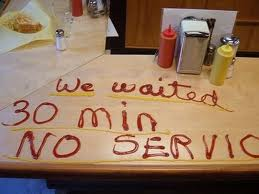Q: The difference between Customer Service and Customer Experience? A: Emotion-driven behaviour.
We’ve all seen “Customer Service” and “Customer Experience” labels freely interchangeable in role descriptions, job titles and team functions. They are seen as one and the same thing.
Does it matter? After all, it’s about “putting the customer at the heart of everything we do” (whatever that means in practice). I’d argue it matters a lot; they are very different disciplines with potential for a very different impact on the bottom line.
I’d suggest there are one or two crucial differences that may help. For me, Customer Service is what we do for our customers and clients; Customer Experience meanwhile is what that service really looks like to be on the receiving end of it.
And then there’s the difference in outcomes – Customer Service is generally tracked retrospectively by internal performance metrics while Customer Experience – functionally and emotionally – affects the way customers feel, think and behave next time.
A recent example brings the differences to life.
Buying a rail ticket online should be a straightforward transaction. Indeed, they have a comprehensive website, a booking engine that caters for all needs, navigation that is (for the most part) intuitive and a helpline in case there are any questions or problems. Lots of Customer Service boxes ticked then.
So, feeling reassured and confident, I book a short day-return journey. I’m then asked for my seat preferences. Great. Easy to do business with. On to the payment page though and I notice a couple of personalised messages: I must travel off-peak and there are no seats available. Uh-oh. Confidence turns to anxiety and confusion.
I know I selected to travel off-peak, so why are they making an issue of it here? Worse, there is no information about exactly what times are peak or off-peak. And they are happy for me to pay yet there are no seats and no alternatives offered. What’s that about?
Maybe I was too fussy in my choice so I start over (there’s no option to amend what I’ve done so far). Same result. After the third time, confusion morphs into frustration so I call the helpline. What do I get? Charged a handsome rate, back to the beginning and a voice-activated question and answer system. After 20 minutes battling with the computer I’m finally told I’m being put through to someone who can take my payment. But then, not only is it such a bad line I can’t hear what they’re saying but the price has suddenly gone up. Once again we get into seat availability and unclear cost options. Honestly, how hard can it be?
Frustration becomes exasperation becomes anger. But that quickly evaporates when I hatch a cunning plan, wrestle back control and smile smugly as I hang up and go back online to book a bus.
The Customer Service was in place, with all good intentions and yet the reality was that it produced a range of emotions and took too much effort for me to become a customer, let alone a frequent traveller or an advocate.
The brand is what the brand does, as they say and experiences don’t always mirror what the Customer Service manual says should happen.
So if we’re not confident we know what today’s customers will say about their experience over dinner tonight, we should at the very least not assume that Customer Service and Customer Experience are one and the same thing.
Jerry Angrave Customer Experience Consultant +44 (0) 7917 718 072 www.customerexperience.uk.com [email protected] Twitter – @IdealExperience LinkedIn – http://uk.linkedin.com/in/improvecustomerexperiences
Leave a Reply
Want to join the discussion?Feel free to contribute!